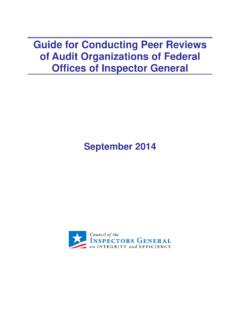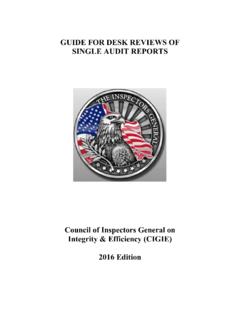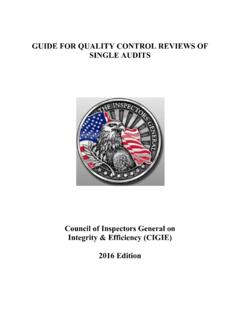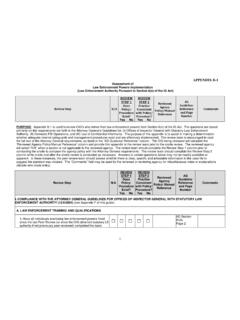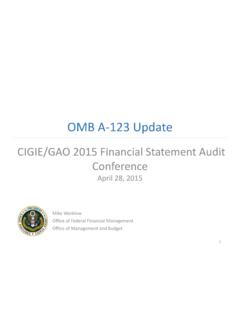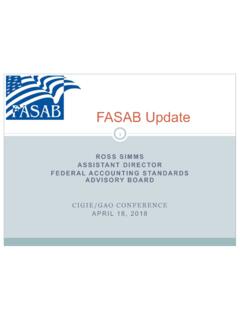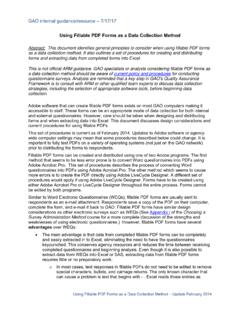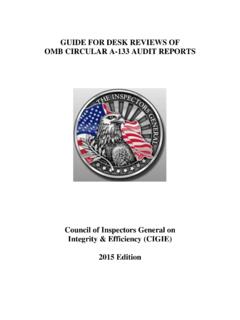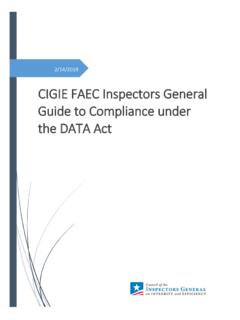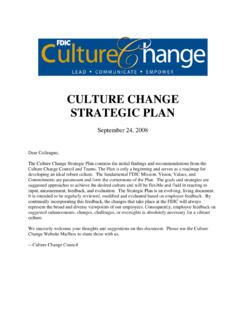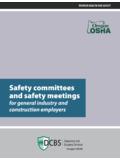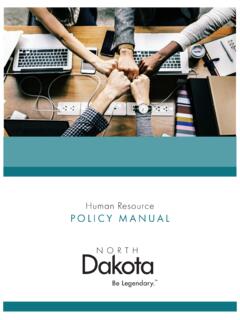Transcription of Quality Standards for Inspection and Evaluation
1 Quality Standards for Inspection and Evaluation December 2020 Letter from the Inspection and Evaluation Committee Chair and Vice Chair The Quality Standards for Inspection and Evaluation (Blue Book) has long provided a solid framework for Inspection and Evaluation (I&E) work by Offices of Inspector General (OIG). In June 2010, the Council of the Inspectors General on Integrity and Efficiency (CIGIE) officially adopted the Standards for all I&E work performed by member organizations. The Blue Book provides OIGs with a flexible and effective mechanism for oversight and empowers our Inspection , Evaluation , and multidisciplinary staff to produce timely, credible reports to improve agency operations.
2 Over the last few years, we have made great strides in moving the I&E community forward. The I&E peer review process began in 2017. As a result of feedback from the I&E community during the peer review process, and at the direction of the I&E Committee, the I&E Roundtable began revising the Standards . For this December 2020 revision, there is a new structure for the Blue Book that provides clarity on the specific requirements for each standard while also providing guidance on how Inspection organizations may comply with the Standards .
3 We believe these revised Standards preserve the flexibility that is a hallmark of I&E work while continuing to provide OIGs with a valuable means of timely and credible oversight. We want to personally thank everyone who worked to revise the Blue Book and to give special recognition to the Blue Book Working Group for leading the effort on this project. We also appreciate the input and feedback given by the Roundtable, I&E Committee, and CIGIE members. The collaborative effort helped guide the project and enhanced the final product.
4 This revision of the Blue Book has been adopted by CIGIE and supersedes the 2012 version. In addition, this revision is effective for all inspections and evaluations beginning on or after January 1, 2022. Sincerely, Wendy Laguarda Mark Greenblatt I&E Committee Chair I&E Committee Vice Chair Inspector General Inspector General Farm Credit Administration Department of the Interior Table of Contents Preface .. 1 Blue Book Structure .. 2 Standard 1: Independence .. 3 Standard 2: Competence .. 5 Standard 3: Planning.
5 8 Standard 4: Evidence Collection and Analysis .. 11 Standard 5: Reporting .. 15 Standard 6: Follow-up .. 18 Standard 7: Quality Control .. 19 1 Preface Inspections and evaluations have long been used by oversight organizations as flexible and effective mechanisms to fulfill their mission. Inspections and evaluations are systematic and independent assessments of the design, implementation, and results of operations, programs, or policies. Inspections and evaluations may be conducted by single-disciplinary teams of personnel, or by multi-disciplinary teams, using multiple methods for gathering and analyzing data.
6 These reviews provide timely, credible information that is useful for managers, policymakers, and others. Oversight organizations can use inspections or evaluations to determine efficiency, effectiveness, impact, and sustainability of operations, programs, or policies. Inspections and evaluations often recommend improvements and identify where corrective action is necessary. Other uses of inspections and evaluations include, but are not limited to: Providing factual and analytical information; Measuring performance; Assessing internal controls; Determining compliance with applicable law, regulation, and policy; Identifying savings, funds put to better use, and questioned costs; Sharing best practices and approaches.
7 And Assessing allegations of fraud, waste, abuse, and endorses the Quality Standards for Inspection and Evaluation and, in compliance with the Inspector General Reform Act of 2008, expects the application of these Standards throughout the Inspector General community. The Standards provide a framework for performing both Inspection and Evaluation work. Fulfilling the Standards takes mindful consideration and does not constitute a checklist. Rather, the Standards should serve as guideposts to help inspectors make each of the many decisions involved in conducting an Inspection or Evaluation .
8 The Standards are flexible and not overly prescriptive by design. The Blue Book is meant to be interpreted through the professional judgment of inspectors due to the complexity of Inspection and Evaluation work. Some oversight organizations make a distinction between Inspection and Evaluation work. However, the Blue Book does not delineate between inspections and evaluations and thus uses the terms Inspection , inspector, and Inspection organization to encompass both inspections and Evaluation oversight work.
9 CIGIE reviews the Blue Book periodically to ensure its continuing relevancy and sufficiency. However, it is the responsibility of each oversight organization that conducts inspections or evaluations to develop internal written policies and procedures to ensure that all such work complies with the Blue Book and any legislation, regulation, or Standards applicable to an organization s operations. 2 Blue Book Structure The Blue Book is formatted to ensure inspectors are quickly able to identify Standards , requirements, and application guidance.
10 Each standard is numbered and contains a brief statement describing the concept and importance of the standard. Requirements for satisfying the standard are outlined in bold boxes and use the word must to indicate the requirement. Inspectors and Inspection organizations must comply with all requirements to satisfy the standard. Requirements are followed immediately by application guidance that relates directly to the preceding requirements. The application guidance further explains the requirements and, in some cases, provides examples and best practices for satisfying the requirements.
